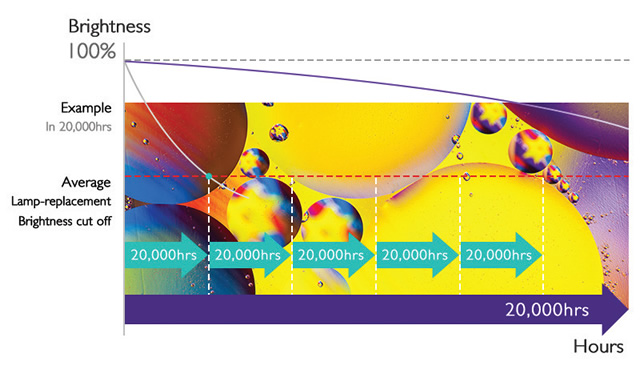Best Projectors for Schools
Ditch lamp projectors for laser projectors to save time and money
Buying a projector for a school isn't simple.
There are many considerations beyond price alone that impact
the total cost of ownership (TCO). Before selecting a projector
for your school, be well aware of all the associated costs of both
lamp and lamp-free projectors to get the most out of the budget
and to prolong the life of the technology investment.
Hidden Costs
For decades, lamp-based projectors have ruled the classroom.
While these models can seem like a great value, there’s
more than just the initial upfront price tag to consider.
Replacement lamps, or projector bulbs, are essential to these
projectors — and the root of many problems and additional
costs. Schools bear the expense of maintaining a healthy supply
of replacement lamps as well as the labor to replace them and
any fees for properly disposing of them.
While keeping replacements on hand is smart, sometimes
it’s hard to locate them. There is no guarantee that a model
that was purchased to last 10 years will have a replacement
lamp five years later. Many manufacturers are discontinuing
lamp-based models or getting out of the projector business
completely. If replacements are found, they can run anywhere
from $50-$400.
Not only does it cost money to buy and store lamps, but
also to dispose of them. Many projector lamps contain hazardous
chemicals, such as mercury gas, which means that they
shouldn’t be thrown in the trash. The Environmental Protection
Agency recommends recycling bulbs, but in many states and
local jurisdictions, it’s a requisite and can incur additional fees.
Another challenge is that a projector lamp gradually goes
dim over its lifetime. A lamp typically lasts a maximum of
5,000 hours, but the average is actually closer to 2,000 hours.
Even with a new lamp, the brightness can be all over the map.
The lamp brightness slowly deteriorates as the projector is used,
and as schools can use a projector for hours every day, they’re
having to replace lamps sooner to get the same brightness,
which can quickly drive up costs and maintenance.
The second most expensive cost is the filter, which is
designed to keep dust out of the projector. Dust that is left to
build up on a filter can cause a projector to overheat and eventually
short it out. However, there are two expenses involved in
cleaning the filter. One is the labor, which may require as little
as blowing off the dust or as much as thoroughly washing and
drying them before they’re put back in. For one or two projectors,
that job isn’t too arduous, but with 20 or more, it becomes
a much more time-consuming task. In an auditorium or gymnasium,
where the projector is mounted on the ceiling, there’s also
the expense of renting a lift to reach it.
The Solution
While a majority of projectors today use lamps, the
purchase of lamp-free projectors is on the rise, according to
Futuresource. In the first quarter of 2020, more than a third of
all 3,500-lumen and brighter projectors were lamp-free. There
are three major lamp-free projector technologies: 100% LED, a
hybrid of LED/laser, and 100% blue laser.
LED options can quickly be ruled out because the brightest
options available are only 2,000 ANSI lumens, which is bright
enough for darkened home theaters but not a well-lit classroom.
In addition, they’re not intended for hours of daily use.
While adding laser light sources to LEDs does amp up the
brightness, the light source warranty may be only rated for a
maximum of 6,000 hours on many models.
Completely sealed blue laser projectors are the ideal choice
for classrooms for several reasons. These lasers are the only
lamp-free projector technology capable of delivering 5,000
lumens or higher at 4K resolution, 20,000 hours of performance,
and meet Rec. 709 or UHD color standard for proven
color accuracy.

The best blue laser projector models offer a sealed engine,
which eliminates the need for a filter, lowering the projectors TCO
even further. Rather than relying on a paper or cloth filter for dust
protection, filter-free laser projectors feature a completely sealed
laser engine that prevents dust from entering and shortening the
life of the unit. The most rigorously tested models have earned
an international dustproof protection rating of IP5X or IP6X, a
testament of the projector’s ability to protect against dust over the
entire life of the projector.
Projectors have been a classroom mainstay for years and
will continue to play a pivotal role in education as the cost
of blue laser projectors come down. Laser projectors provide
schools with a budget-friendly, zero-maintenance option that
is future-ready and user- friendly. Don’t you think it’s time to
make the upgrade?
This article originally appeared in the Fall 2020 issue of Spaces4Learning.
About the Author
Bob Wudeck serves as Senior Director of Business Development for BenQ, a visual display solutions provider.